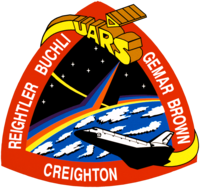STS-48
 | |
| Dane misji | |
| Indeks COSPAR | 1991-063A |
|---|---|
| Zaangażowani | |
| Oznaczenie kodowe | STS-48 |
| Pojazd | |
| Wahadłowiec | |
| Załoga | |
 L-P: Mark Brown, Charles (Sam) Gemar, John Creighton, James Buchli i Kenneth Reightler, | |
| Dowódca | |
| Start | |
| Miejsce startu | |
| Początek misji | 12 września 1991 23:11:04 UTC |
| Orbita okołoziemska | |
| Apogeum | 580 km |
| Perygeum | 575 km |
| Okres orbitalny | 96,2 min |
| Inklinacja orbity | 57° |
| Lądowanie | |
| Miejsce lądowania | Edwards AFB, Pas startowy 22 |
| Lądowanie | 18 września 1991 07:38:42 UTC |
| Czas trwania misji | 5 dni, 8 godz, 27 min, 38 sek[1] |
| Przebyta odległość | 3 530 369 km[1] |
| Liczba okrążeń Ziemi | 81[1] |
| Program lotów wahadłowców | |
STS-48 (ang. Space Transportation System) – trzynasta misja wahadłowca kosmicznego Discovery i czterdziesta trzecia programu lotów wahadłowców[2].
Załoga[2]
- John Creighton (3)*, dowódca
- Kenneth Reightler, Jr. (1), pilot
- James Buchli (4), specjalista misji 1
- Charles „Sam” Gemar (2), specjalista misji 2
- Mark N. Brown (2), specjalista misji 3
- *(liczba w nawiasie oznacza liczbę lotów odbytych przez każdego z astronautów)
Parametry misji[1]
- Masa:
- startowa orbitera: 108 741 kg
- lądującego orbitera: 87 318 kg
- ładunku: 7854 kg
- Perygeum: 575 km
- Apogeum: 580 km
- Inklinacja: 57,0°
- Okres orbitalny: 96,2 min
Cel misji
Umieszczenie na orbicie satelity UARS (Upper Atmosphere Research Satellite) badającego atmosferę ziemską, a zwłaszcza jej warstwę ozonową[2].
Zobacz też
Przypisy
Linki zewnętrzne
- podsumowanie misji STS-48 na stronie NASA (ang.)
- Mark Wade: STS-48 (ang.). W: Encyclopedia Astronautica [on-line]. [dostęp 2017-07-25].
- Spaceflight mission report: STS-48 (ang.). W: Spacefacts [on-line]. [dostęp 2017-07-25].
Media użyte na tej stronie
The flag of Navassa Island is simply the United States flag. It does not have a "local" flag or "unofficial" flag; it is an uninhabited island. The version with a profile view was based on Flags of the World and as a fictional design has no status warranting a place on any Wiki. It was made up by a random person with no connection to the island, it has never flown on the island, and it has never received any sort of recognition or validation by any authority. The person quoted on that page has no authority to bestow a flag, "unofficial" or otherwise, on the island.
The STS-48 crew portrait includes (front row left to right): Mark N. Brown, mission specialist; John O. Creighton, commander; and Kenneth S. Reightler, pilot. Pictured on the back row (left to right) are mission specialists Charles D. (Sam) Gemar, and James F. Buchli. The crew of five launched aboard the Space Shuttle Discovery on September 12, 1991 at 7:11:04 pm (EDT). The primary payload of the mission was the Upper Atmosphere Research Satellite (UARS).
STS-48 Mission Insignia
- Designed by the astronaut crewmembers, the STS 48 patch represents the Space Shuttle Orbiter Discovery in orbit about the Earth after deploying the Upper Atmospheric Research Satellite (UARS) depicted in block letter style. The stars are those in the Northern Hemisphere as seen in the fall and winter when UARS will begin its study of Earth's atmosphere. The color bands on Earth's horizon, extending up to the UARS spacecraft, depict the study of Earth's atmosphere. The triangular shape represents the relationship among the three atmospheric processes that determine upper atmospheric structure and behavior: chemistry, dynamics and energy. In the words of the crewmembers, This continuous process brings life to our planet and makes our planet unique in the solar system."


